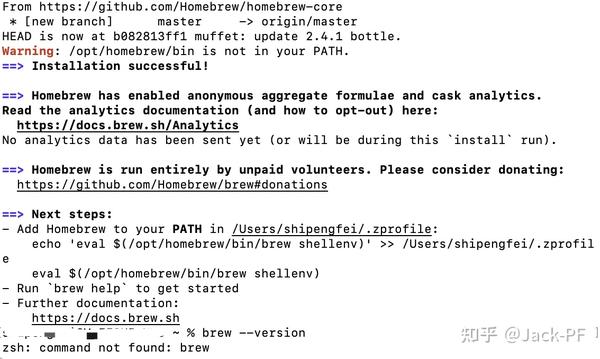For bundler I did the following on Catalina $ brew install v8@3.15 $ bundle config build.libv8 -with-system-v8 $ bundle config build.therubyracer -with-v8-dir=$(brew -prefix v8@3.15) $ bundle install Worked on Big Sur, tks! Brew Macos Catalina Additionally, SUMO provides native macOS application bundles for its graphical applications, so they can be added to the macOS dock. There is a separate brew cask that will copy these bundles to the Applications folder: brew cask install sumo-gui. For the macOS platform, you can install the Azure CLI with homebrew package manager. Homebrew makes it easy to keep your installation of the CLI update to date. The CLI package has been tested on macOS versions 10.9 and later. The current version of the Azure CLI is 2.25.0. For information about the latest release, see the release notes.

Greetings friends! After I upgraded my old MacBook Pro to High Sierra 10.13, Terminal surprised me with something like this: “telnet command not found on Mac”. What? It turns out! He was deleted! Well, here the question arose of how to return telnet on Mac?
Install Telnet on Mac via Homebrew
You must first install the missing Homebrew package manager. What does Homebrew do? Homebrew installs the packages you need that are not provided by Apple. Use this step-by-step guide for the fastest solution:
- Install Homebrew via Terminal:
- Install telnet using the Homebrew package manager:
- We are waiting for the installation to complete;
- Now telnet is installed on macOS High Sierra. We check the performance:
Read more:How to Use the Port Scanner in macOS Network Utility?
Brew Command Not Found Mac Os Catalina Update
Conclusion
Of course, now few people use the telnet protocol, because there is SSH more powerful and secured tool, but still telnet sometimes could be necessary. Apple is so reckled about our security from that to exclude telnet from the list of basic Terminal commands on Mac.
anaconda catalina zsh
zsh: command not found: conda
conda command not found mac
anaconda 2019.10 installer
zsh: command not found: jupyter
anaconda-navigator not responding mac
update anaconda
I've just updated my MacBook to Catalina. After the update, zsh can't find anymore. In fact, in my .zshrc I had:
However, the path /anaconda3/bin doesn't exist anymore. Does that mean that I have lost all of my environment?
You can find the entire anaconda3 environment in a shortcut link named 'Relocated Items' on your desktop. It appears as though the upgrade to Catalina does not allow the Conda environment to be installed under a user directory now likely having to do with the new system volume move to a read-only partition.
This issue has been opened as far back as June 10th, I am a little disappointed that it was not resolved before the Catalina upgrade came around.
There is a solution that appears to work without losing your environment, see this link: https://github.com/ContinuumIO/anaconda-issues/issues/10998#issuecomment-539215005
From the link:
Copy the folder anaconda3 located in Relocated Items to /Users/myname/
Open Terminal
Enter:
export PATH='/Users/myname/anaconda3/bin:$PATH'Enter:
conda init zsh

How to Restore Anaconda after Update to MacOS Catalina, How to Restore Anaconda after Update to MacOS Catalina Apple has decided that Anaconda's default install location in the root folder is not allowed. available shell installers, and found them to work fine with Catalina. Oct 10, 2019. By Anaconda Team. MacOS Catalina was released on October 7, 2019, and has been causing quite a stir for Anaconda users. Apple has decided that Anaconda’s default install location in the root folder is not allowed. It moves that folder into a folder on your desktop called “Relocated Items,” in the Security folder.
Anaconda has published a blog post on the issue. There seem to be two main options:
Reinstallation: for now shell installer only (you’ll need to wait for the new installer if you rely on the GUI instead).
Repair (experimental): will allow you to fix your old installation and keep all of your old environments

You can check the Anaconda website for further information.
Anaconda not working in Mac Catalina, While the new version of MacOS - Mac Catalina - won't allow that. Move the folder to ~ i.e. /Users/[your_user_name] since it can't be moved back to root dir, i.e., / . No command 'conda init bash' , then upgrade the conda version. I found it anaconda-navigator and the other related files as follows:. 1 After installed macOS Catalina, we can switch the terminal from bash to zsh. There are many advantages from using zsh instead of bash, but One of the issues with zsh is some of the frameworks (jupyter notebook,conda) are not supported directly. Once I typed jupyter notebook in terminal to run it.
If you are using zsh, conda installer adds a conda init script at the end of your ~/.bash_profile file. You should copy it and paste into your ~/.zshrc file.
Brew Command Not Found Mac Os Catalina Download
Setting up Anaconda3 to work with macOS Catalina zsh shell, I found out upon updating my MacBook Pro to the latest macOS Catalina, Anaconda3 is no longer working with the latest zsh Contents within this block are managed by 'conda init' !! Get unlimited access to the best stories on Medium — and support writers while you're at it. Just $5/month. Upgrade After upgrading to macOS Catalina, the Python Anaconda environment moves certain files from root directory to “Relocated Items” folder and the Anaconda navigator app does not work AS-IS. Go to the
None of the existing answers worked for me but this one does.
Download anaconda's self-contained prefix replacement tool at https://repo.anaconda.com/pkgs/misc/cpr-exec/cpr-0.1.1-osx-64.exe and make it executable:
Move your anaconda3 folder from Relocated Items to your home folder: ~/anaconda3.
Fix your folder using the following command:
Re-run conda init to fix your conda shell command:
If you are using zsh,replace the last command with:
Configuring Anaconda environment on macOS Catalina, After upgrading to macOS Catalina, the Python Anaconda and create a directory by using command “mkdir anaconda3” if it does not exist. Since macOS 10.15, the default shell is not bash, but zsh. It might explain why modifying your .bashrc did not help. According to the FAQ, what you should do in case conda was not set up correctly is not to modify the PATH variable manually, but instead try to run. source <path to conda>/bin/activate
There is now a fix from anaconda.

Another key change since the last release is that Apple released macOS version 10.15 – Catalina. Unfortunately, this was a breaking release for previous versions of Anaconda that used the pkg installer. The Anaconda Distribution 2019.10 installers address the issues and should install without trouble on macOS Catalina. If you would rather repair your current Anaconda installation, please check out this blog post for tips.
- Delete old installs first.
- Install the new 2019.10+ distro.
- Open Terminal/cmd Test out
conda -V - Test out
jupyter notebook
Everything worked perfectly for me, no need to change paths or anything.
Anaconda won't start in Mac terminal ZSH, After upgrading to macOS Catalina, the Python Anaconda and create a directory by using command “mkdir anaconda3” if it does not exist. A number macOS Catalina problems and issues have arisen after its release. That’s always been the case with newly-released operating systems, which means it’s hardly a surprise.
Configuring Anaconda environment on macOS Catalina, I believe you're referring to MacOS, but I experience the same thing on Linux with is 'Zsh command not found: conda' being thrown after upgrading to Catalina Apple this week officially released macOS Catalina (also known as macOS 10.15), the first major update to its Mac operating system since Mojave last year.
'Zsh command not found: conda' being thrown after upgrading to , Actual Behavior After updating Mac OS to Catalina (beta 3), Anaconda stopped use conda on the command line and similarly conda is not working after the upgrade to Catalina. FWIW, I found my old conda environments at Since this issue began for me right after updating conda to 4.8.3, I suspect the update conda command is not replacing libffi.7.dylib correctly. 👍 3 Copy link Quote reply
Mac Catalina · Issue #11105 · ContinuumIO/anaconda-issues · GitHub, When trying to install Anaconda with Python 3.7 on MacOS Catalina, the I've found that the upgrade to Catalina moves the 'anaconda3' folder to your It seems Catalina's security settings may not allow applications to * To upgrade from Lion or Mountain Lion, first upgrade to El Capitan, then upgrade to Catalina. To find your macOS version, Mac model, memory, and storage space, choose About This Mac from the Apple menu . If your Mac isn't compatible with macOS Catalina, the installer will let you know. View the complete list of compatible computers.
Comments
- Apple is assaulting open-source, and especially Machine Learning and Data Science users. There seems to be a solution that will be out soonish... but so far you're stuck with the hack below.
- After following the steps to move the
anaconda3directory, I found thatjupyter notebookkernel was crashing. I had to manually change the launcher arguments in/Users/[myusername]/Library/Jupyter/kernels/python3/kernel.json. - This isn't working for me, I'm still getting a
zsh: /Users/me/anaconda3/bin/conda: bad interpreter: /anaconda3/bin/python: no such file or directoryerror when I runconda init zsh. Is there anything else I can do? - I think the export command needs double quotes ie
export PATH='/Users/myname/anaconda3/bin:$PATH'otherwise$PATHwon't get substituted correctly and all your old path locations will disappear - for the issue that Kyle had, you have to replace the first line in the anaconda3/bin/conda file with #!/Users/<my_user>/anaconda3/bin/python
- I tried all of this, it didn't work. After trying this I literally entered /Users/<my user name>/anaconda3/bin and double-clicked on the file activate
- Reinstallation did not work for me! jupyter does not open! an editor pops up
- I installed Anaconda using command-line-install, following the steps explained in this link. It worked for me.
- I did the same too. it did not.
- I followed all the instructions from the blog post and it worked for me!
- This also worked for me. This is the approach recommended by Anaconda. anaconda.com/…
- Thanks for pointing out that the new command to start the notebook is
conda run jupyter notebook. That did it for me.